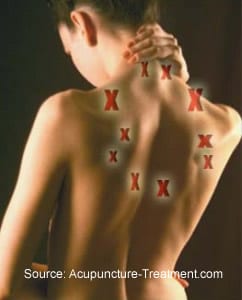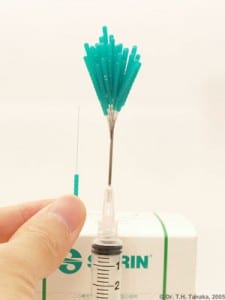Dry Needling and Trigger Point Therapy
What are “Trigger Points”?
 Trigger points, also known as trigger sites or muscle knots, are described as “hyper-irritable spots in skeletal muscle that are associated with palpable nodules in taut bands of muscle fibers.” (1) Integrated Physical Medicine’s chiropractors and acupuncturists, Dr. Eric Mitz and Dr. Miachael Ray, commonly see trigger points occurring in the muscles of the neck, shoulders, TMJ, pelvis, and hip though they can and do occur in any muscle. Trigger points appear as knots and are almost always painful when pressed or palpated.
Trigger points, also known as trigger sites or muscle knots, are described as “hyper-irritable spots in skeletal muscle that are associated with palpable nodules in taut bands of muscle fibers.” (1) Integrated Physical Medicine’s chiropractors and acupuncturists, Dr. Eric Mitz and Dr. Miachael Ray, commonly see trigger points occurring in the muscles of the neck, shoulders, TMJ, pelvis, and hip though they can and do occur in any muscle. Trigger points appear as knots and are almost always painful when pressed or palpated.
An unusual characteristic of Trigger Points that differentiate them from the typical tight muscles is their ability to refer pain to distant parts of the body. Just like the heart muscle, which refers pain to the left arm and jaw when in spasm (i.e., heart attack), trigger points in a given muscle have a predictable and reproducible pattern of pain referral. (1) These referred pains from the trigger points often confuse patients (and health care practitioners that do not specialize in treating joint and myofascial pain syndromes) as to the real cause of their discomfort.
It is also important that the practitioner appreciates the fact that tight muscles may be a protective mechanism created by the body to stabilize an area that has a more serious issue. Also, patients with chronic, widespread and stubborn trigger points may have myofascial pain syndrome. In these patients, a well-meaning but naïve practitioner may be able to eliminate the trigger point(s) but will, in fact, create more and bigger problems for their patient. This is why it is important to always be evaluated and diagnosed by a reputable chiropractor, osteopath or medical physician before beginning treatment.
How do You Treat “Trigger Points”?
There are several techniques of Trigger Point therapy used by Dr. Mitz, Dr. Ray, and their staff at their Evansville chiropractic and acupuncture clinic to relieve the pain and eliminate the trigger points. Commonly used forms of conservative therapy for muscle spasms and trigger points include stretching, heat/ice, electric muscle stimulation, and ultrasound in conjunction with manual muscle therapy (Trigger Point massage, myofascial release), chiropractic adjustments (manipulation) and acupuncture Trigger Point Dry Needling.
What is “Dry Needling”?
Many of our patients have questions about dry needling. To explain what it is, “Dry Needling” is an alternative to Trigger Point Injections and is used by Dr. Mitz and Dr. Ray to eliminate their patients’ painful Trigger Points. The phrase “Dry Needling” was coined in 1979 by Czech physician Karl Lewit who reported that he had similar positive outcomes as the typical anesthetic/steroid injections for the treatment of trigger points by simply inserting a “dry” needle without injecting any of the liquid (i.e., “wet”) medications. (4)
Dry Needling vs Acupuncture
Thousands of years ago, acupuncturists determined the location for their therapy by observing patient’s responses to palpation of their painful muscles. These trigger points are called “ashi” points. In the English translation, the Chinese “ashi” means “Ah yes!” as in “Ah Yes, that’s the spot!”. Research published in Pain (the official journal of the International Association for the Study of Pain) established that “every trigger point [reported in the Western medical literature] has a corresponding acupuncture point.”(2) The Dry Needling vs Acupuncture debate continues, but in my opinion, Dry Needling may, in reality, be a modern Western version of an ancient form of Chinese acupuncture first documented over 2,000 years ago! (2)
 Dry Needling involves painlessly inserting an acupuncture needle (i.e., a “Dry Needle”) directly into the active trigger point followed by special and specific manipulations of the needle aimed at eliminating the trigger point(s). Dry Needling may provide nearly instantaneous relief from the painful trigger point(s) as well as improved function and mobility. Patients are nearly unanimous in their praise for the results they achieve and are always surprised by how easy and pain-free Dry Needling is. Research has shown dry needling to be a very effective intervention! (3) The picture to the right demonstrates just how small the Acupuncture needles used in Dry Needling are: You can fit over 20 of them INSIDE the opening of a regular hypodermic needle!
Dry Needling involves painlessly inserting an acupuncture needle (i.e., a “Dry Needle”) directly into the active trigger point followed by special and specific manipulations of the needle aimed at eliminating the trigger point(s). Dry Needling may provide nearly instantaneous relief from the painful trigger point(s) as well as improved function and mobility. Patients are nearly unanimous in their praise for the results they achieve and are always surprised by how easy and pain-free Dry Needling is. Research has shown dry needling to be a very effective intervention! (3) The picture to the right demonstrates just how small the Acupuncture needles used in Dry Needling are: You can fit over 20 of them INSIDE the opening of a regular hypodermic needle!
Dry Needling is a safe and effective intervention for trigger points when performed by a licensed acupuncturist or physician trained in this approach. There are risks, of course, and Dr. Mitz or Dr. Ray will discuss them with you before your treatments commence.
If you suffer from muscle spasms and trigger points, you need a comprehensive strategy tailored to your unique needs to get you rapid relief from your pain.
References
- Travell, Janet; Simons David; Simons Lois (1999). Myofascial Pain and Dysfunction: The Trigger Point Manual (2 vol. set, 2nd Ed.). USA: Lippincott Williams & Williams.
- Melzack R, Stillwell DM, Fox EJ. Trigger points and acupuncture points for pain: correlations and implications. Pain. 1977 Feb;3(1):3–23.
- Kietrys DM et al titled “Effectiveness of Dry Needling for Upper-Quarter Myofascial Pain: A Systematic Review and Meta-analysis,” J Orthop Sports Phys Ther 2013;43(9):620–634.
- Lewit K (1979). “The needle effect in the relief of myofascial pain”. Pain 6 (1): 83–90.







